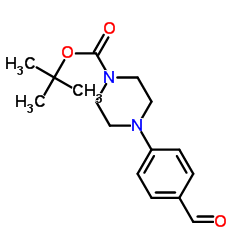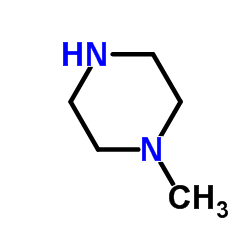342405-34-9
| Name | [4-(4-methylpiperazin-1-yl)phenyl]methanol |
|---|---|
| Synonyms |
(4-(4-Methylpiperazin-1-yl)phenyl)methanol
[4-(4-methyl-piperazin-1-yl)-phenyl]-methanol [4-(4-Methyl-1-piperazinyl)phenyl]methanol p-(4-methylpiperazinyl)benzylalcohol 4-(4-N-Methylpiperazinyl)benzyl alcohol methylpiperazinophenylmethanol [4-(4-Methylpiperazino)phenyl]methanol Benzenemethanol, 4-(4-methyl-1-piperazinyl)- [4-(4-Methylpiperazin-1-yl)phenyl]methanol 4-(4-Methylpiperazino)benzyl Alcohol 4-(4-Methylpiperazino)benzylAlcohol |
| Density | 1.1±0.1 g/cm3 |
|---|---|
| Boiling Point | 363.7±42.0 °C at 760 mmHg |
| Melting Point | 118-120ºC |
| Molecular Formula | C12H18N2O |
| Molecular Weight | 206.284 |
| Flash Point | 189.4±26.5 °C |
| Exact Mass | 206.141907 |
| PSA | 26.71000 |
| LogP | 0.62 |
| Vapour Pressure | 0.0±0.9 mmHg at 25°C |
| Index of Refraction | 1.570 |
| Storage condition | 2-8°C |
Synonym: Section 2 - COMPOSITION, INFORMATION ON INGREDIENTS
Risk Phrases: 20/21/22 34 Section 3 - HAZARDS IDENTIFICATION EMERGENCY OVERVIEW
Harmful by inhalation, in contact with skin and if swallowed. Causes burns. Potential Health Effects Eye: Causes eye burns. Skin: Harmful if absorbed through the skin. Causes skin burns. Ingestion: Harmful if swallowed. Causes gastrointestinal tract burns. Inhalation: Harmful if inhaled. Causes chemical burns to the respiratory tract. Chronic: Not available. Section 4 - FIRST AID MEASURES Eyes: Immediately flush eyes with plenty of water for at least 15 minutes, occasionally lifting the upper and lower eyelids. Get medical aid immediately. Skin: Get medical aid immediately. Immediately flush skin with plenty of water for at least 15 minutes while removing contaminated clothing and shoes. Ingestion: Do not induce vomiting. Get medical aid immediately. Inhalation: Get medical aid immediately. Remove from exposure and move to fresh air immediately. If not breathing, give artificial respiration. If breathing is difficult, give oxygen. Notes to Physician: Treat symptomatically and supportively. Section 5 - FIRE FIGHTING MEASURES General Information: As in any fire, wear a self-contained breathing apparatus in pressure-demand, MSHA/NIOSH (approved or equivalent), and full protective gear. Extinguishing Media: Use foam, dry chemical, or carbon dioxide. Section 6 - ACCIDENTAL RELEASE MEASURES General Information: Use proper personal protective equipment as indicated in Section 8. Spills/Leaks: Vacuum or sweep up material and place into a suitable disposal container. Section 7 - HANDLING and STORAGE Handling: Do not breathe dust, vapor, mist, or gas. Do not get in eyes, on skin, or on clothing. Use only in a chemical fume hood. Storage: Store in a cool, dry place. Store in a tightly closed container. Corrosives area. Section 8 - EXPOSURE CONTROLS, PERSONAL PROTECTION Engineering Controls: Facilities storing or utilizing this material should be equipped with an eyewash facility and a safety shower. Use adequate ventilation to keep airborne concentrations low. Exposure Limits CAS# 342405-34-9: Personal Protective Equipment Eyes: Not available. Skin: Wear appropriate protective gloves to prevent skin exposure. Clothing: Wear appropriate protective clothing to prevent skin exposure. Respirators: Follow the OSHA respirator regulations found in 29 CFR 1910.134 or European Standard EN 149. Use a NIOSH/MSHA or European Standard EN 149 approved respirator if exposure limits are exceeded or if irritation or other symptoms are experienced. Section 9 - PHYSICAL AND CHEMICAL PROPERTIES Physical State: Solid Color: off-white Odor: almond-like pH: Not available. Vapor Pressure: Not available. Viscosity: Not available. Boiling Point: Not available. Freezing/Melting Point: 118 - 120 deg C Autoignition Temperature: Not available. Flash Point: Not available. Explosion Limits, lower: Not available. Explosion Limits, upper: Not available. Decomposition Temperature: Solubility in water: Specific Gravity/Density: Molecular Formula: C12H18N2O Molecular Weight: 206.29 Section 10 - STABILITY AND REACTIVITY Chemical Stability: Not available. Conditions to Avoid: Incompatible materials. Incompatibilities with Other Materials: Strong oxidizing agents. Hazardous Decomposition Products: Nitrogen oxides, carbon monoxide, carbon dioxide. Hazardous Polymerization: Has not been reported Section 11 - TOXICOLOGICAL INFORMATION RTECS#: CAS# 342405-34-9 unlisted. LD50/LC50: Not available. Carcinogenicity: [4-(4-Methylpiperazino)phenyl]methanol - Not listed by ACGIH, IARC, or NTP. Section 12 - ECOLOGICAL INFORMATION Section 13 - DISPOSAL CONSIDERATIONS Dispose of in a manner consistent with federal, state, and local regulations. Section 14 - TRANSPORT INFORMATION IATA Shipping Name: CORROSIVE SOLID, TOXIC, N.O.S.* Hazard Class: 8 (6.1) UN Number: 2923 Packing Group: III IMO Shipping Name: CORROSIVE SOLID, TOXIC, N.O.S. Hazard Class: 8 (6.1) UN Number: 2923 Packing Group: III RID/ADR Shipping Name: CORROSIVE SOLID, TOXIC, N.O.S. Hazard Class: 8 UN Number: 2923 Packing group: III Section 15 - REGULATORY INFORMATION European/International Regulations European Labeling in Accordance with EC Directives Hazard Symbols: C Risk Phrases: R 20/21/22 Harmful by inhalation, in contact with skin and if swallowed. R 34 Causes burns. Safety Phrases: S 26 In case of contact with eyes, rinse immediately with plenty of water and seek medical advice. S 36/37/39 Wear suitable protective clothing, gloves and eye/face protection. S 45 In case of accident or if you feel unwell, seek medical advice immediately (show the label where possible). WGK (Water Danger/Protection) CAS# 342405-34-9: No information available. Canada None of the chemicals in this product are listed on the DSL/NDSL list. CAS# 342405-34-9 is not listed on Canada's Ingredient Disclosure List. US FEDERAL TSCA CAS# 342405-34-9 is not listed on the TSCA inventory. It is for research and development use only. SECTION 16 - ADDITIONAL INFORMATION N/A |
| Hazard Codes | C:Corrosive |
|---|---|
| Safety Phrases | S26-S36/37/39-S45 |
| RIDADR | UN 1759 |
| HS Code | 2933599090 |
|
~87% 
342405-34-9 |
| Literature: RVX Therapeutics Inc.; McLure, Kevin G.; Young, Peter Ronald Patent: US2013/281397 A1, 2013 ; Location in patent: Paragraph 0522; 0523 ; |
|
~72% 
342405-34-9 |
| Literature: Papagni, Antonio; Buttero, Paola Del; Bertarelli, Chiara; Miozzo, Luciano; Moret, Massimo; Pryce, Mary T.; Rizzato, Silvia New Journal of Chemistry, 2010 , vol. 34, # 11 p. 2612 - 2621 |
|
~% 
342405-34-9 |
| Literature: New Journal of Chemistry, , vol. 34, # 11 p. 2612 - 2621 |
|
~% 
342405-34-9 |
| Literature: New Journal of Chemistry, , vol. 34, # 11 p. 2612 - 2621 |
| Precursor 4 | |
|---|---|
| DownStream 2 | |
| HS Code | 2933599090 |
|---|---|
| Summary | 2933599090. other compounds containing a pyrimidine ring (whether or not hydrogenated) or piperazine ring in the structure. VAT:17.0%. Tax rebate rate:13.0%. . MFN tariff:6.5%. General tariff:20.0% |






